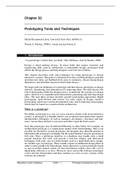Summary
Summary Prototyping Tools and Techniques
- Course
- Institution
1. Introduction “A good design is better than you think” (Rex Heftman, cited by Raskin, 2000). Design is about making choices. In many fields that require creativity and engineering skill, such as architecture or automobile design, prototypes both inform the design process and help designer...
[Show more]



